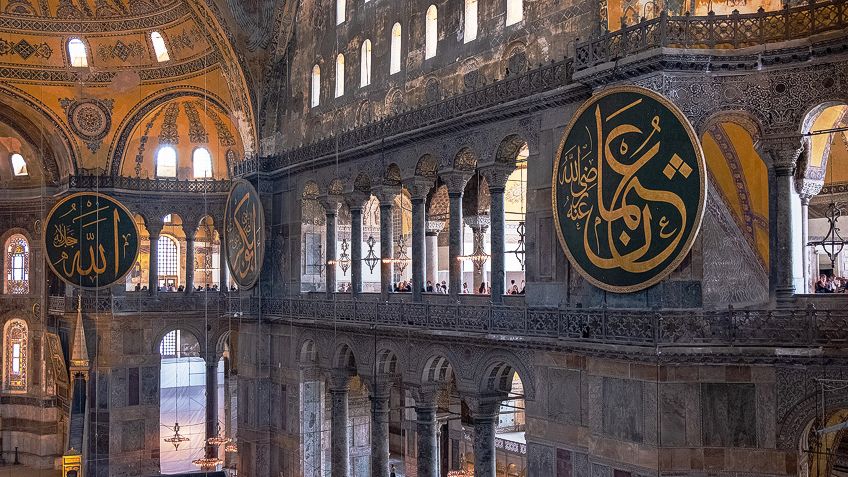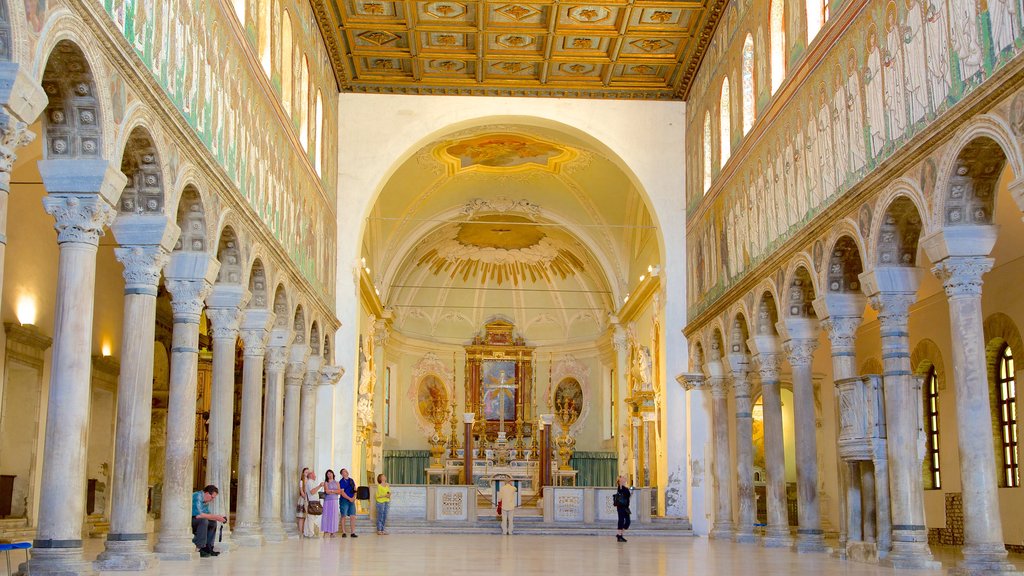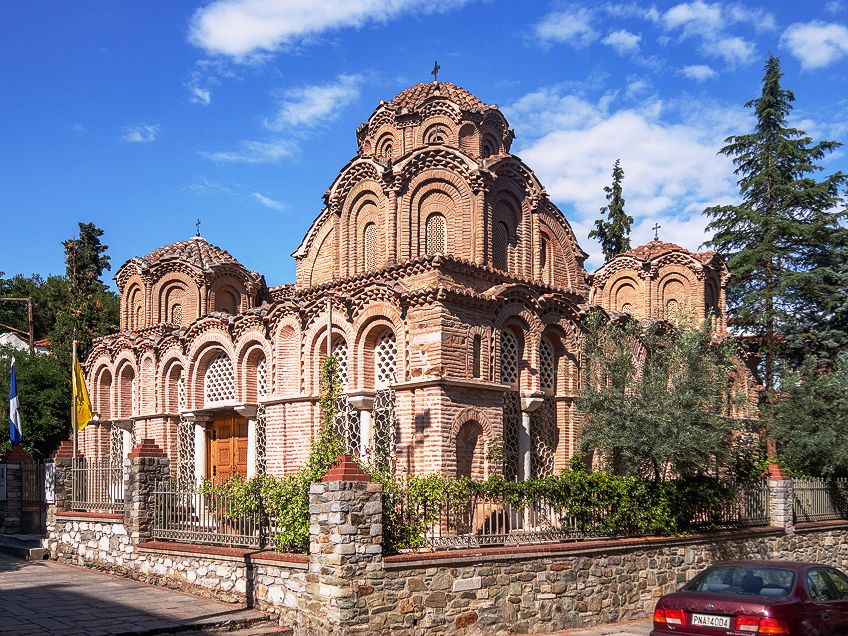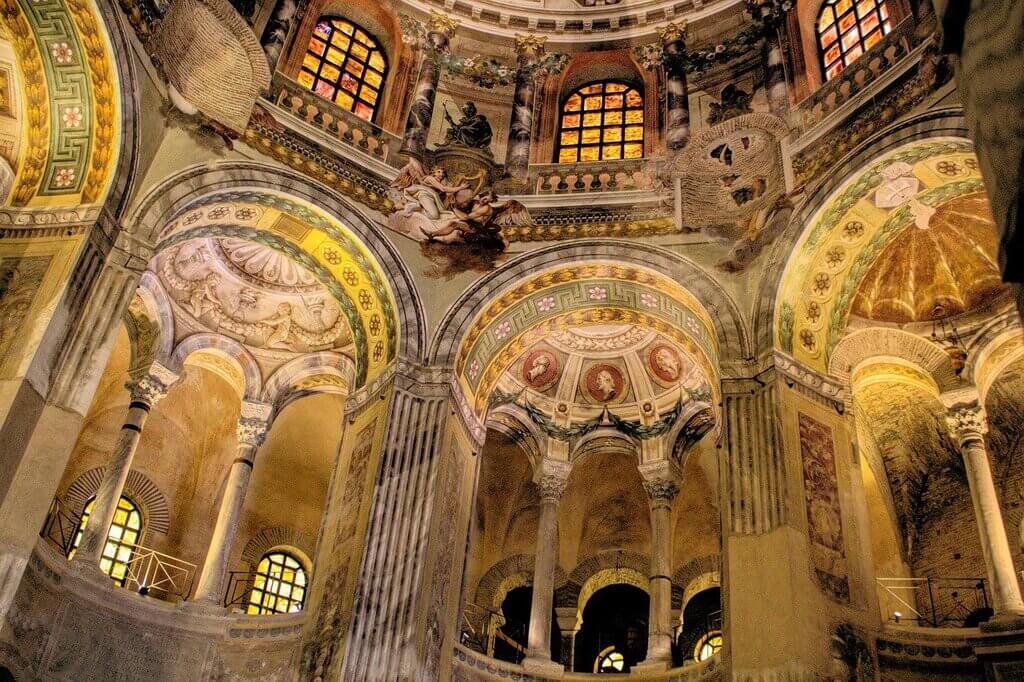Byzantine architecture is an intriguing style that has had a lasting impact on the world. These structures, from the towering domes to the exquisite mosaics, are lovely to look at. They also convey the story of a culture and a people who overcame several challenges to create something phenomenal.
These Byzantine buildings, such as the Hagia Sophia and the San Vitale Basilica, are testaments to the human spirit’s strength, ingenuity, and perseverance. So, whether you’re an architectural lover or someone who appreciates beauty and history, let’s explore the world of Byzantine architecture and uncover its wonders.
What Is Byzantine Architecture?
Byzantine architecture was among the three greatest forces in European architecture during the Middle Ages. This architectural style emerged during the reign of the Roman Emperor Justinian between 527 and 565 AD. It is distinguished by the best structural advancements of the time as well as several religious influences.

Byzantine architecture, like Byzantine art, was heavily influenced by Orthodox Christianity and aimed to honor God by constructing masterpieces. It is popular for its use of intricate mosaics, lavishly decorated domes, and iconic “horseshoe” arches, which give it a distinct, attractive aspect.
The ancient city of Constantinople, which is now Istanbul, Turkey, was the heart of the Byzantine Empire. With strong influences from Classical Roman and Early Christian architecture, Byzantine architecture is known for its grandeur in church design.
History of Byzantine Architecture
Byzantine buildings are the remains of the Byzantine era, which lasted from the fourth to the fifteenth century. Many have since become museums, which are admired by people of different religions, nations, and artistic temperaments. Let’s dive into Byzantine history:
a). Start of the Byzantine Era
The Byzantine era started in 330 AD when Roman Emperor Constantine moved the Roman Empire’s capital to Byzantium, and henceforth it became known as the Eastern Roman Empire. Soon after, the Byzantine capital’s name was changed to Constantinople to honor Constantine. Byzantine art and architecture expanded from the east to the west across the European continent.
b). Association with Eastern Orthodoxy
Following the Great Schism of the Roman Catholic Church in 1054, Byzantine architecture became more prevalent in the Eastern Orthodox Church than in Catholic areas of western Europe. Nonetheless, early Byzantine architecture affected all European church architecture, including Gothic and Romanesque architectural styles.
Although these magnificent churches are still appreciated today for their religious art and ornamentation, they were sometimes altered due to the rise of iconoclasm during the middle Byzantine period.
c). Fall of the Byzantine Empire
Byzantine architecture spread across the continent for as long as the empire existed, including during the Crusades. The late Byzantine architectural movement and empire came to an end only after the fall of Constantinople to the Ottoman Empire in 1453. Constantinople became Istanbul, and many Byzantine churches were converted into mosques.
Characteristics of Byzantine Architecture
Byzantine architecture has several characteristics that will help you identify it. They include:
1. Mosaics

Image Credit: wittycircle.com
The most popular element in Byzantine architecture is using mosaics. Byzantine mosaics portrayed religious symbolisms and historical figures, and they also decorated the ceilings and walls of different churches built during this period. Mosaics were constructed by Byzantine craftsmen for the Byzantine Empire and also for the churches built by the Norman Kings of Sicily and the Venetians.
The Hagia Sophia in Istanbul houses one of the most extensive collections of these mosaics. It features hundreds of mosaics, many of which are covered by a coating of plaster made by the Ottoman Empire.
2. Round Arches

Image Credit: architecturesstyle.com
Another important characteristic of Byzantine architecture that remained even after the Western Roman Empire fall,is the round arch, which the Ancient Romans mostly used. These round arches were also a prominent feature of Romanesque architecture, which was significantly influenced by Byzantine works of architecture.
Byzantines used round arches to create most openings in their buildings, and they continued to use round arches even after the rest of Europe had embraced the pointed Gothic arch.
3. Domes

Image Credit: mymodernmet.com
Byzantine structures are also characterized by their unique domes. Previously, these large hemispherical roofs were supported by a square-shaped foundation. The creation of one hefty design on top of another needed a great deal of attention to detail and accuracy.
Two techniques were used to achieve this:
-
- Using a squinch, which is an arch in every corner of a square base that transforms it into an octagon
-
- Using a pendentive
4. Greek Cross Plan

Image Credit: wittycircle.com
The Byzantine Empire’s early churches had symmetrical floor plans. They had square walls and flat roofs. This floor plan was known as the Latin cross plan.
However, the Greek cross plan quickly replaced the Latin cross. The floor design was cross-shaped, with four equal arms at right angles to one another. A perfect example of the Greek cross plan is the Byzantine church of the Holy Apostles in Athens.
Byzantine Architecture Examples
Below are nine examples of famous architectural marvels from the Byzantine era.
1. Hagia Sophia, Istanbul, Marmara, Turkey
The Hagia Sophia is the world’s most important Byzantine architectural masterpiece. The most notable aspect of this building is that it was constructed in under 5 years and 10 months.

Image Credit: mymodernmet.com
Not only was the church built in such a short period, but it was also the world’s largest structure at the time.
Image Credit: reddit.com
Another impressive feature is Hagia Sophia’s dome, which became the world’s biggest dome at the time of completion since it overtook the Pantheon’s dome housed in Rome.

Image Credit: artincontext.org
The interior is particularly popular for its gold additions throughout the interior and in the domes. While the Hagia Sophia Byzantine building is now a mosque, it has previously served as a church and a public museum.

Image Credit: mymodernmet.com
2. Basilica of Sant’Apollinare Nuovo
The Basilica of Sant’ Apollinare Nuovo is another must-see Byzantine church in Ravenna, despite its exterior appearance.

Image Credit: expedia.ca
Since the basilica was erected between 475 and 526 AD by the Ostrogoth king Theodoric the Great, it contains a combination of many different architectural styles.

Image Credit: expedia.ca
Byzantine Emperor Justinian transformed the basilica into an Orthodox church in 561 AD, only a few decades after it was finished. He ordered Byzantine architects to decorate the walls with mosaics portraying Ravenna sites and scenes from the Bible.

Image Credit: dreamstime.com
Since the mosaics are so well conserved, this church has also been designated as a UNESCO World Heritage Site.
3. Hagia Irene
Hagia Irene, also known as Hagia Eirene, is among the earliest churches built, and it was commissioned by Constantinople’s founder, Roman Emperor Constantine the Great.
Image Credit: fineartamerica.com
After Constantine’s Hagia Eirene was destroyed by fire, it was renovated by Justinian in the sixth century and significantly reconstructed by Emperor Constantine V in the eighth century, when its arch was ornamented with a small mosaic cross.

Image Credit: artincontext.org
The Turkish government stored their weapons in the Hagia Irene until they transformed it into a museum in the eighteenth century.

Image Credit: istanbulclues.com
After serving as an armory for decades during the Ottoman period, it became the Ottoman Empire’s first museum in the nineteenth century and is now used as a concert venue.
4. Church of Saint Catherine, Thessaloniki
The city of Thessaloniki is home to one of the most famous Byzantine churches, the Church of Saint Catherine, although it served as a mosque for most of its existence. Thessaloniki had an important seaport and a formidable defense system that rivaled that of the Byzantine capital, Constantinople.

Image Credit: artincontext.org
The Byzantine church architecture was built between 1261 and 1453, just before the downfall of the Byzantine Empire, which is why it served as a mosque for most of its existence.
_j.jpg)
Image Credit: thebyzantinelegacy.com
This building is one of two UNESCO World Heritage Sites in Thessaloniki. The second is Greece’s only remaining Byzantine bath, which is also worth a visit.
5. Basilica of San Vitale- Ravenna, Emilia-Romagna, Italy
The Church of San Vitale, also known as the Basilica of San Vitale, was constructed in the sixth century and is considered a masterpiece in Byzantine architecture.

Image Credit: viator.com
It is a UNESCO World Heritage Site, completed in 547 AD, and houses a collection of some of the most exquisite Byzantine mosaics.

Image Credit: architecturesstyle.com
The Basilica of San Vitale is most notable for its colorful mosaics and Christian iconography decorating the interior walls and ceilings.

Image Credit: thousandwonders.net
This Byzantine church architecture is a perfect example of a centrally planned church with Byzantine mosaics, which have some of the best depictions of Emperor Justinian the Great and his wife, Theodora.
6. St. Mark’s Basilica, Venice
St. Mark’s Basilica, also known as the Patriarchal Cathedral Basilica of St. Mark’s Basilica, is a unique example of Byzantine architecture. It is an example of Italo-Byzantine design, which is an Italian interpretation of the architectural style.

Image Credit: artincontext.org
The cathedral, located near Piazza San Marco, is heavily influenced by the Hagia Sophia. Some of the church’s artifacts were brought directly from the Hagia Sophia following the Fourth Crusade.
Image Credit: flickr.com
St. Mark’s Basilica church has unique ornamentation, and it has been known as Chiesa d’Oro, or Church of Gold, since the 11th century because of its lavish interior.
Image Credit: dreamstime.com
Although most of this theater is influenced by Byzantine architecture, it also exhibits many characteristics of Renaissance and Gothic architecture.
7. Hosios Loukas – Distomo, Greece
Hosios Loukas is a magnificent 10th-century monastery on Greece’s Mount Helicon. It is a major example of Byzantine architecture, often known as the Second Golden Age and the Macedonian Renaissance.

Image Credit: ba-bamail.com
The Byzantine Empire was ruled by the Macedonian dynasty between the 9th and 11th centuries, which invested heavily in the arts.
Image Credit: theepochtimes.com
The Hosios Loukas monastery and the nearby Katholikon church are among the most remarkable examples of Byzantine architecture.

Image Credit: ba-bamail.com
Inside the monastery, there is a wealth of magnificent marblework, mosaics, and frescoes. Since 1990, the monastery has been designated as a UNESCO World Heritage Site.
8. Basilica of Saint’Apollinare -Classe, Emilia-Romagna, Italy
This is another of the Byzantine churches that were built by Justinian I around Ravenna in the sixth century.

Image Credit: avrvm.it
Saint’Apollinare in Classe is architecturally comparable to Saint’Apollinare Nuovo. The church is built in the Roman basilica style, with the nave and aisles all pointing towards the altar.

Image Credit: pinterest.com
The apse, which is beautifully decorated with Byzantine mosaics, is the most important part of the basilica.
9. Monastery of the Panocrator, Turkey
The Pantocrator Monastery is Istanbul’s second-largest Byzantine holy building still existing. The monastery is made up of two churches and a little chapel.

Image Credit: architecturesstyle.com
All of these structures are made of brick, with mortar joints that are wider than the bricks themselves.
Image Credit: mountathos360.com
This method was popular in Byzantine architecture at the time, and it may be found in a range of structures throughout Anatolia, Greece, and the Balkans.

10. The Basilica Cistern – Istanbul, Turkey
Not all Byzantine architecture is dazzling in gold and evident for miles. Indeed, you could easily walk right past the basilica cistern, or rather, above it, without notice. This is because of the Basilica Cistern’s underground location.
Image Credit: propertyturkey.com
The building is a massive underground water storage tank and a remarkable illustration of Byzantine urban planning. This cistern was also commissioned by Justinian I and was named “the Basilica Cistern” since it was built near an old basilica.
Image Credit: interestingengineering.com
The cistern was created to supply water to the entire city, including Justinian’s house. The space can accommodate 2,800,000 cubic feet of water, or roughly 32 Olympic-size swimming pools.

There are 336 huge marble columns, many of which include decorative carvings and medusa heads, which are an impressive sight today, making the cistern a popular tourist site.
Conclusion on Byzantine Architecture

To this day, Byzantine architecture captivates and inspires people. These temples, with their characteristic domes and elaborate mosaics and frescoes, offer a glimpse into a world of amazing beauty and imagination.
Byzantine architectural style tells the tale of a people who, despite adversity, constructed something truly magnificent that inspires awe and wonder even today. We hope our article has allowed you to experience Byzantine architecture and learn more about it.














